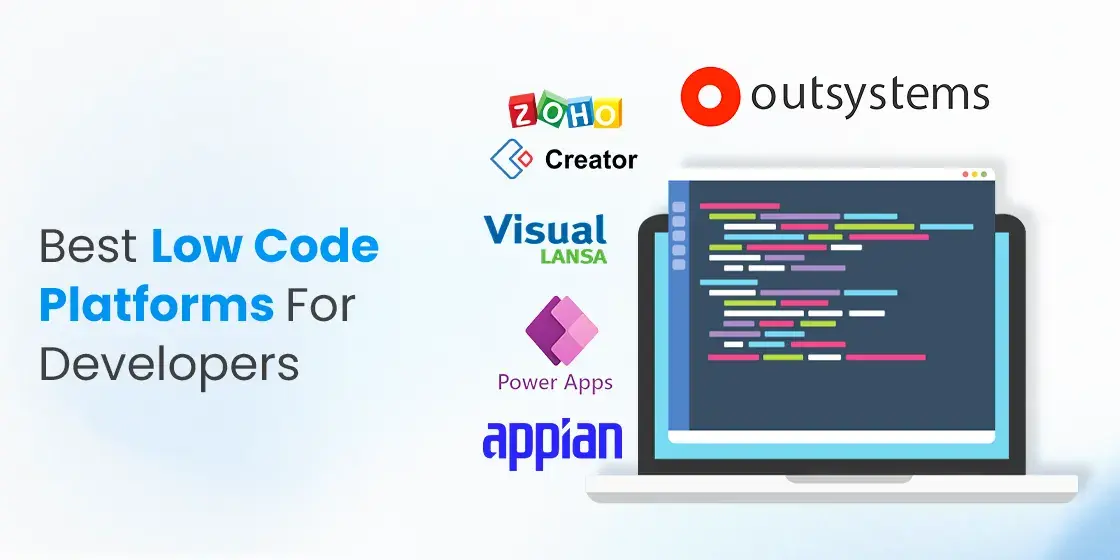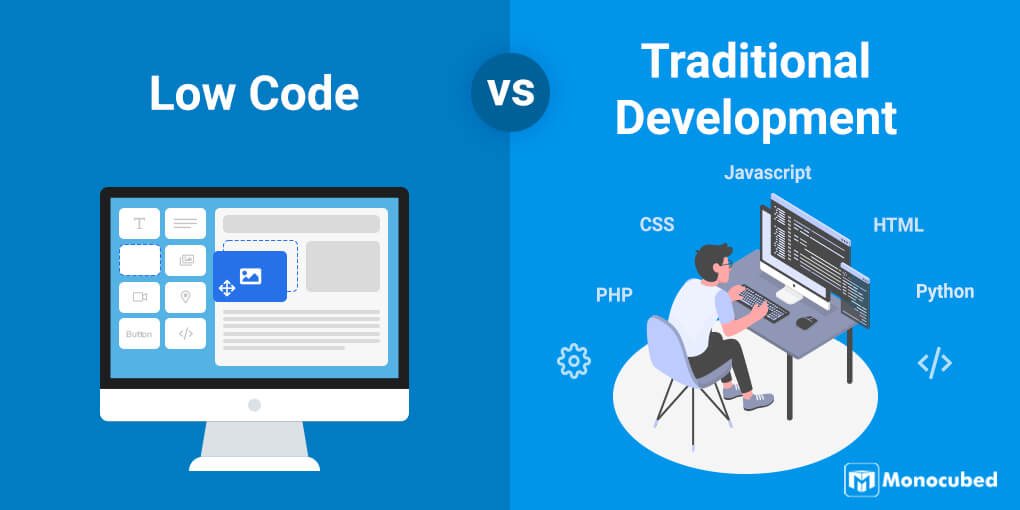Good News To Picking Low-Code Platform Examples
Wiki Article
Benefits Of Low-Code Application Development Terms Of Speed
Visual Development Environment:
Drag-and-Drop Interfaces: Low-code platforms provide visual tools for designing applications. Drag-and-drop elements allow developers to build apps quickly without writing code.
A lot of low-code platforms come with already-built templates and parts. This allows developers to quickly build or prototype applications, without having start with a blank slate.
Reduced Coding Needs:
Automated code generation: Low-code platforms create the code base on visual models created and maintained by the developers. This eliminates the need to code manually and speeds up development.
Reusable Components: Developers may use reusable components across different projects, minimizing the time that is spent creating and testing code.
Collaboration Streamlined:
Low-code platforms come with a variety of tools that allow seamless collaboration between teams working on development. These include version control, testing and deployment.
Citizen development: Through the use of intuitive interfaces and reducing bottlenecks that are often caused by insufficient availability of developers, business users as well as non-developers can contribute towards application development.
Rapid Iteration and Prototyping:
Rapid Prototyping. Developers can build prototypes in a short time to test their ideas and receive feedback. This can lead to a quicker iteration process.
Easy modifications. The visual nature that low-code development gives makes it easy to modify and update applications. This speeds up the process of improving and refining applications by incorporating feedback from users.
Pre-built Integrations:
API Integrations: Low-code platforms typically come with pre-built connectors for popular services and APIs, reducing the time required to connect external systems.
Data Integration: Inbuilt instruments to integrate data simplify the process of connecting to databases and other sources of data, speeding up development.
Deployment of Scaling:
One-Click Installation: A lot of low-code platforms provide an installation with a single click, reducing the amount of effort and time required to install applications.
Cloud-based solutions: Cloud low-code platforms are capable of scaling and infrastructure management. Developers are able to concentrate on the functions and application logic instead of deployment logistics.
Overall, the benefit of developing low-code applications in terms of speed is in the ability of it to automatize and simplify many elements of the process, which allows for rapid delivery of apps and more rapid adaptation to evolving requirements. Take a look at the best Low-code Platform for application development for website advice including stored sql procedures, app platforms, app modernization, push alerts, app modernization, azure sql databases, app modernisation, application modernization software, application development platforms, low code platforms and more.

Scalability And Flexibility Are The Two Advantages Of Low Code Application Development
Low-code software has many advantages when it comes to scalability. They are scalable and flexible, and they can be adapted to new requirements. Here are the main advantages: Rapid Scaling
Cloud-Based Deployment: A lot of low-code applications are cloud-based, enabling applications to scale effortlessly with the cloud infrastructure. This enables businesses to manage increased loads without worrying about the management of servers.
Auto-Scaling: The auto-scaling feature will automatically adjust the resources based on demand. This ensures the same performance even during peak hours and without manual intervention.
Flexible Architecture:
Low-code platforms facilitate modular design, allowing components to independently be designed, assessed and adapted. This modularity improves flexibility and facilitates modifications or expansions to specific components without affecting the entire system.
Microservices Integration: Support for microservices architecture allows applications to be built as a set of loosely coupled services, which improves both scalability and flexibility.
Solutions that can be customized:
Extensibility: Low-code platforms typically allow for custom coding and scripting, enabling developers to extend the functionality of the application beyond what is already available. This allows businesses to satisfy the requirements of their particular business.
Third-Party Integrations: The capacity of companies to integrate APIs and third-party apps, as well as add new functionalities to the application when required, expands the capabilities of the application.
Agile Development and Deployment
Continuous Delivery and Deployment Low-Code Platforms facilitate agile methods through enabling continuous integration and Continuous Delivery (CI/CD). This enables rapid deployment of new features and updates, ensuring that applications can evolve quickly as a result of user feedback and market shifts.
Iterative development: Low-code development is iterative, which means applications can be scaled and developed gradually. This decreases the risk of large-scale changes while allowing a controlled growth.
Resource Optimization
Efficient Resource management: Low-code platform tools help optimize resource use by monitoring and managing performance of the applications. This ensures that resources are utilized effectively and efficiently can be scaled up or down depending on actual requirements.
Load Balance: This function lets the application manage massive traffic by distributing workloads over several servers. It also ensures performance is consistent.
Global Reach
Multi-Region Implementation: Low-code platforms can be implemented across a variety of geographic regions. This enables companies to offer users high-quality, low-latency services across the world. This is essential, especially when it comes to applications that have global users.
Localization: Support for localization is included, which allows for applications to be easily adaptable to different languages or regional requirements. This increases flexibility for various markets.
Updates and maintenance
Maintenance is made easier by the modularity and appearance of low-code applications makes maintenance easier, allowing for quick updates and bugfixes to be made without long downtime.
Version Control: Integrated version control system helps keep track of changes and rollbacks. This ensures that updates can be easily installed and older versions restored when needed.
Cost Efficiency:
Lower development costs: By reducing the need for extensive programming, low-code platforms reduce development costs and allow to scale applications without a substantial increase in effort and expense.
Pay-As You-Go Models - Many low-code applications have flexible pricing models, such as pay-as-you go that aligns costs with actual usage, growth and financial flexibility.
The ability to scale low-code applications allows businesses to develop robust and flexible, scalable and robust applications. These platforms allow for quick changes to the demands of changing times as well as efficient utilization of resources and constant improvement, which ensures that applications can develop and grow with the business. Check out the top Enterprise application development with Low-code Platform recommendations for blog recommendations including push notifications android, app modernization, cross platform mobile development, app modernisation, azure sql databases, developing mobile apps, developing mobile apps, jdbc server, develop mobile application, app modernization and more.

Regarding Support From Vendors And Community Involvement, Low-Code Development Has Many Advantages.
Low-code development platforms for applications can be an excellent way to get vendor support and community involvement. Both of these aspects are vital for ensuring a successful implementation and ongoing maintenance of the app. These are the main benefits:Vendor support
Comprehensive Technical Support:
Support Teams Dedicated to You Numerous low-code platforms provide dedicated support teams who can assist in technical problems, problem-solving and provide guidance. This will ensure that any issues are swiftly solved.
24/7 Support: Some suppliers provide support 24/7, which is particularly beneficial for global businesses operating across various time zones.
Training and Onboarding
Vendors often provide organized programs for users, such as tutorials and webinars. They can also offer certificates.
Many companies offer customized onboarding that helps customers to use the platform efficiently and customize it to meet the needs of their customers.
Regular updates and enhancements
Continuous Improvement : Low-code platform manufacturers often release regular updates that include new functionality, performance enhancements and security patches. These updates make sure that their platform is current and secure.
Feedback Integration Vendors incorporate customer feedback into the development process and ensure that the platform is updated to adapt to changing requirements.
Comprehensive Documentation:
Documentation: Detailed documentation is offered for all products. It includes everything from basic to advanced customization. This can help users find solutions by themselves.
API References API documentation can help developers customize and integrate applications using the Low-Code platform.
Professional Consulting Services
Expert Consultation : Vendors offer consulting services, such as architecture design and complex implementations. They do this to ensure that users can benefit from the platform.
Custom Development Services: Certain companies offer custom development services to develop specific features or integrations that are not included in the default.
Community Support
Active User Communities:
Forums and discussion boards Discussion boards and forums: Many low-code platforms offer vibrant online communities that let users ask questions, exchange solutions and share best practices.
User Groups & Meetups Virtual or local user groups and meetings offer opportunities for learning, networking and sharing experiences.
Collaboration and sharing of knowledge:
Community-Contributed Resources: Users often share templates, modules, and extensions that they have developed, which can be reused or adapted by others, accelerating development and innovation.
Crowdsourced problem solving: The collective knowledge and experience of the crowd is an invaluable resource for troubleshooting problems and coming up with innovative solutions.
Learning and Development
Community-led training Community-led training: Many groups provide training sessions, webinars, and workshops led by experts who are experienced in the area.
Tutorials and online courses Community members usually develop and publish online courses, tutorials, and how-to guide, improving the learning resources for all users.
Feedback and Influence
Product Feedback Channels. Community forums usually include channels that allow users to give feedback to the company. Feedback from customers can influence the development and improvement of new features.
Beta Testing Programs. Active community members can participate in beta-testing programs. They will have early access to the latest features of the platform, and also an have the opportunity to influence the evolution of the platform.
Recognition and Support
Many vendors offer community recognition programs. These programs recognize active community members, and can include MVP programs.
Peer Support Peer Support: Community members often offer peer support by sharing their knowledge and offering advice for users who are not as knowledgeable. This fosters a collaborative friendly and supportive environment.
Overall, the combination of robust vendor support and a vibrant and engaged community creates an extensive support system for development of low-code applications. The users will have the knowledge and resources they need to develop, deploy and maintain their application.
